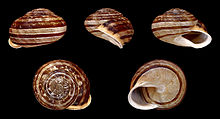Diverticular cochlea
| Diverticular cochlea | ||||||||||||
|---|---|---|---|---|---|---|---|---|---|---|---|---|

Diverticular snail ( Massylaea vermiculata ) |
||||||||||||
| Systematics | ||||||||||||
|
||||||||||||
| Scientific name | ||||||||||||
| Massylaea vermiculata | ||||||||||||
| ( OV Müller , 1774) |
The eobania vermiculata ( Massylaea Vermiculata , syn .: Eobania Vermiculata ), even pasta snail called, is a land snail from the family of Helicid (Helicidae); this family belongs to the subordination of land snails (Stylommatophora).
features
The housing measures 14–22 × 22–30 mm in the adult animals. It is flat conical with a spherical habit . It has 5 to 6 slightly arched turns that increase evenly until the last handle. The seam between the whorls is relatively shallow. The mouth drops sharply in relation to the winding axis of the first whorls. It is inclined, slightly flattened above (dorsal) and below (ventral) and has a wide, outwardly turned white edge of the mouth. The inside of the mouth is thickened like a lip. The navel is completely closed by the callus-like, thickened edge of the mouth. The shell is relatively thick, the basic color of the outside is variable, mostly creamy white, but greenish specimens also occur. The drawing is also very variable. It consists of a five-volume basic pattern that is designed differently and can also be resolved differently. The bands are of different widths and interrupted differently. The surface is pitted, underneath are faint growth stripes that form a fine net pattern with fine longitudinal stripes. Otherwise, the case is smooth and matte. The body of the animal is light gray to light brown in color; The antennae and top of the body are often a little darker.
Occurrence, way of life and distribution
The species occurs in fields, rows of hedges, gardens and vineyards, also in dry locations near the coast. It is distributed from eastern Spain over the Mediterranean area to the Crimean peninsula . In France, it penetrates into the upper Rhone Valley . In the east is the northernmost occurrence in Hungary. Otherwise, the species has now been moved to southern England and Australia. According to the temperature distribution in the distribution area, the animals either hibernate or summer dormancy.
Reproduction
In northern Greece copulation takes place after the first autumn rains. Eggs are laid about 20 days later, and each individual lays about 70 eggs. The young hatch only a little later. Sexual maturity is reached at around 2 years of age. They can live to be around 5 years old.
The diverticulum snail as food
The diverticular snail is intensively collected and eaten in Italy, but also in France and Greece. This has already led to proposals to limit collecting
Individual evidence
- ↑ D. Notton: Eobania Vermiculata in the UK. Mollusc World, 11: 6, Redhill 2006 ZDB ID 2111511-4
- ↑ Eobania vermiculata (Müller) , accessed April 27, 2009
- ^ Italy ( Memento of February 21, 2005 in the Internet Archive )
- ↑ see comment in AnimalBase on animalbase.uni-goettingen.de
literature
- Rosina Fechter, Gerhard Falkner: Mollusks. 287 pp., Mosaik-Verlag, Munich 1990 (Steinbach's Nature Guide 10) ISBN 3-570-03414-3 .
- Michael P. Kerney, RAD Cameron, Jürgen H. Jungbluth: The land snails of Northern and Central Europe. 384 pp., Paul Parey, Hamburg & Berlin 1983, ISBN 3-490-17918-8 .
- Klaus Bogon: Land snails biology, ecology, biotope protection. 404 p., Natur Verlag, Augsburg 1990 ISBN 3-89440-002-1 .
